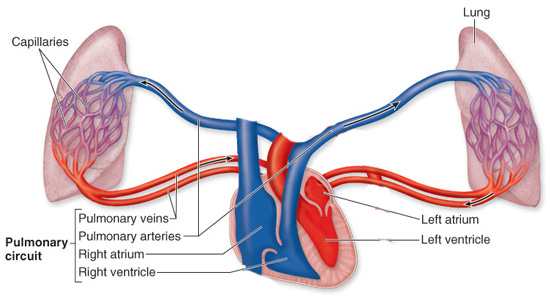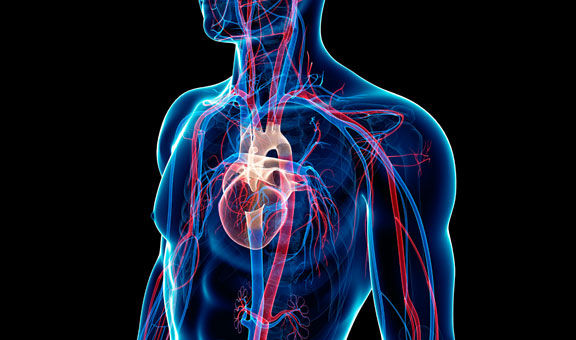The cardiovascular division of the circulatory system is further broken into two (2), the pulmonary and systemic circulation. The pulmonary and systemic circulation make up the two (2) major branches of the cardiovascular system and are connected to either side of the heart. This page should be used as you “analyse the movement of blood through the body and the influence of the circulatory and respiratory systems on movement efficiency and performance”

 The image above shows the movement of blood through the body, beginning at number 1 and progressing until number 11. Our blood continues to flow through the cycle explained above and presented in the diagram over and over again. This Going to the lung via the pulmonary circulation, where it is oxygenated and then to the bodies cells via the systemic circulation, where it delivers oxygen and removes carbon-dioxide.
This is the movement of blood through the body and the influence of the circulatory and respiratory systems on movement efficiency and performance. That is, the connection between the systems at the pulmonary capillaries around the alveoli and the transport of oxygen and nutrients to myocytes along with the removal of waste products, such as carbon-dioxide (removed via the lungs) and lactic acid allows movement to occur. The better this system works, the more efficiently movement can be performed.
The image above shows the movement of blood through the body, beginning at number 1 and progressing until number 11. Our blood continues to flow through the cycle explained above and presented in the diagram over and over again. This Going to the lung via the pulmonary circulation, where it is oxygenated and then to the bodies cells via the systemic circulation, where it delivers oxygen and removes carbon-dioxide.
This is the movement of blood through the body and the influence of the circulatory and respiratory systems on movement efficiency and performance. That is, the connection between the systems at the pulmonary capillaries around the alveoli and the transport of oxygen and nutrients to myocytes along with the removal of waste products, such as carbon-dioxide (removed via the lungs) and lactic acid allows movement to occur. The better this system works, the more efficiently movement can be performed.
The Pulmonary Circulation
The pulmonary circulation begins at the right side of the heart as the right ventricle pumps blood into the pulmonary artery. The pulmonary artery then carries the de-oxygenated blood to the lungs, where it spreads out into the capillaries that surround the alveoli of the lungs. The blood is then oxygenated, while at the same time carbon-dioxide is removed into the lungs, and the blood then travels back to the heart through the pulmonary artery, which empties into the left atrium. Below is an image of the pulmonary circulation and its various parts.
The Systemic Circulation
The systemic circulation is connected to the left side of the heart and carries blood to the rest of the body in order to deliver oxygenated blood (along with all the other nutrients). This blood travels out of the left ventricle through the aorta, which breaks into various arteries and then down to capillaries. The capillaries then deliver the oxygenated blood and other nutrients to the cells of the body, including myocytes (muscle cells) and removes carbon-dioxide. The blood then continues to travel through the veins and back to the right atrium via the vena cava (the largest vein). The image above shows the movement of blood through the body, beginning at number 1 and progressing until number 11. Our blood continues to flow through the cycle explained above and presented in the diagram over and over again. This Going to the lung via the pulmonary circulation, where it is oxygenated and then to the bodies cells via the systemic circulation, where it delivers oxygen and removes carbon-dioxide.
This is the movement of blood through the body and the influence of the circulatory and respiratory systems on movement efficiency and performance. That is, the connection between the systems at the pulmonary capillaries around the alveoli and the transport of oxygen and nutrients to myocytes along with the removal of waste products, such as carbon-dioxide (removed via the lungs) and lactic acid allows movement to occur. The better this system works, the more efficiently movement can be performed.
The image above shows the movement of blood through the body, beginning at number 1 and progressing until number 11. Our blood continues to flow through the cycle explained above and presented in the diagram over and over again. This Going to the lung via the pulmonary circulation, where it is oxygenated and then to the bodies cells via the systemic circulation, where it delivers oxygen and removes carbon-dioxide.
This is the movement of blood through the body and the influence of the circulatory and respiratory systems on movement efficiency and performance. That is, the connection between the systems at the pulmonary capillaries around the alveoli and the transport of oxygen and nutrients to myocytes along with the removal of waste products, such as carbon-dioxide (removed via the lungs) and lactic acid allows movement to occur. The better this system works, the more efficiently movement can be performed. 
